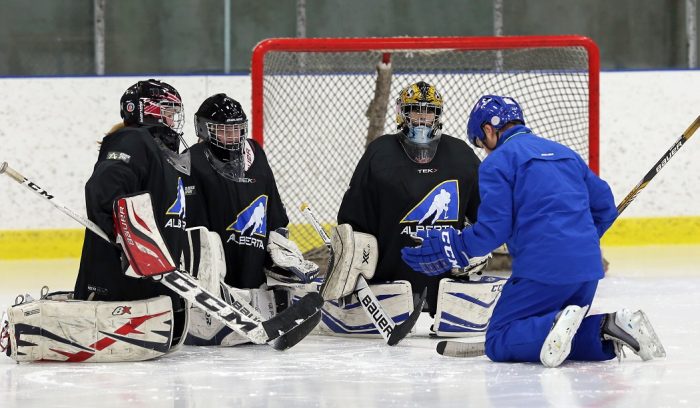Community
Hockey Alberta unveils provincial Goaltender Development Plan

RED DEER – The goaltender position has evolved dramatically over the past few decades.
Not only has the equipment changed and improved, so has the coaching, mechanics and mental training associated with the position.
In order to ensure that Alberta’s goaltenders, and their coaches, are properly equipped for the best performance possible in this specialized position, Hockey Alberta has developed a new Provincial Goaltender Development Plan.
“The goaltender position is a unique one in the sport of hockey. In working with coaches and athletes across the province, we have identified the need to better support the overall training and development of goaltenders,” said Justin Fesyk, Senior Management of Development. “Hockey Alberta’s new goaltender development plan focuses on ensuring goalies at all levels have the chance to enjoy the position and the game of hockey to the fullest.”
The Goaltender Development Plan has a multi-pronged approach. One focal point is on developing the knowledge and expertise of coaches, both regionally and within individual associations. The other prong involves providing goaltenders with specialized training opportunities, where they can work with other goalies as well as some of the most experienced goaltender coaches in the province.
The initial stages of the plan are being implemented over the next few months, in preparation for full operation starting in September for the 2017-18 season.
The first step is to identify and recruit six Goaltender Coach Leads who will be strategically located around the province and work as part of Hockey Alberta’s Regional Centre network. Each Regional Goalie Lead will provide leadership and support to minor hockey associations and Regional Centre Consultants in implementing Hockey Alberta’s Goaltending Development Plan throughout their region.
The position outline and application instructions for the Regional Goaltender Lead positions are available on the Hockey Alberta website. Deadline for applications is February 22.
“The Regional Goalie Leads will be the keys to the success of the Goaltender Development Plan,” said Matt Weninger, Regional Centre South Consultant, and a former Junior A and NCAA goaltender. “The Leads will coordinate support to our minor hockey associations, educating coaches, planning practices and camps, supporting MHAs with their goalie evaluation process, and mentoring coaches.”
In addition to selecting the Regional Leads, a number of training weekends are already scheduled for goaltenders, coaches, and development directors.
For goalies, three goaltender camps have been organized – two open to any 2000-2007 born goaltender, and one targeted at elite level goalies:
- South: May 27-28, Cochrane (led by World Pro Goaltending); open registration
- North: June 3-4, Edmonton (led by ATC Goaltending); open registration
- Elite: June 24-25, Sylvan Lake (led by industry experts). Application forms from interested AAA, AA and Female Elite goaltenders will be reviewed, and 18 male and 18 female goalies to participate.
The big event for coaches and development directors will be June 17-18 at Sylvan Lake, Each Local Minor Hockey Association (LMHA) in Alberta will be able to nominate an individual to attend the Goalie Coach Training Seminar. As well, LMHA development directors will receive training on building a goalie development plan for their own organization. More details on both segments of the Sylvan Lake event will be available in March.
Community
Support local healthcare while winning amazing prizes!

|
|
|
|
|
|
Community
SPARC Caring Adult Nominations now open!

Check out this powerful video, “Be a Mr. Jensen,” shared by Andy Jacks. It highlights the impact of seeing youth as solutions, not problems. Mr. Jensen’s patience and focus on strengths gave this child hope and success.
👉 Be a Mr. Jensen: https://buff.ly/8Z9dOxf
Do you know a Mr. Jensen? Nominate a caring adult in your child’s life who embodies the spirit of Mr. Jensen. Whether it’s a coach, teacher, mentor, or someone special, share how they contribute to youth development. 👉 Nominate Here: https://buff.ly/tJsuJej
Nominate someone who makes a positive impact in the live s of children and youth. Every child has a gift – let’s celebrate the caring adults who help them shine! SPARC Red Deer will recognize the first 50 nominees. 💖🎉 #CaringAdults #BeAMrJensen #SeePotentialNotProblems #SPARCRedDeer
s of children and youth. Every child has a gift – let’s celebrate the caring adults who help them shine! SPARC Red Deer will recognize the first 50 nominees. 💖🎉 #CaringAdults #BeAMrJensen #SeePotentialNotProblems #SPARCRedDeer
-

 Also Interesting2 days ago
Also Interesting2 days ago9 Things You Should Know About PK/PD in Drug Research
-

 Business2 days ago
Business2 days agoCannabis Legalization Is Starting to Look Like a Really Dumb Idea
-

 Business2 days ago
Business2 days agoWEF-linked Linda Yaccarino to step down as CEO of X
-

 Business2 days ago
Business2 days ago‘Experts’ Warned Free Markets Would Ruin Argentina — Looks Like They Were Dead Wrong
-

 Bruce Dowbiggin1 day ago
Bruce Dowbiggin1 day agoThe Covid 19 Disaster: When Do We Get The Apologies?
-

 Media2 days ago
Media2 days agoCBC journalist quits, accuses outlet of anti-Conservative bias and censorship
-

 Business1 day ago
Business1 day agoCarney government should recognize that private sector drives Canada’s economy
-

 Automotive2 days ago
Automotive2 days agoAmerica’s EV Industry Must Now Compete On A Level Playing Field








